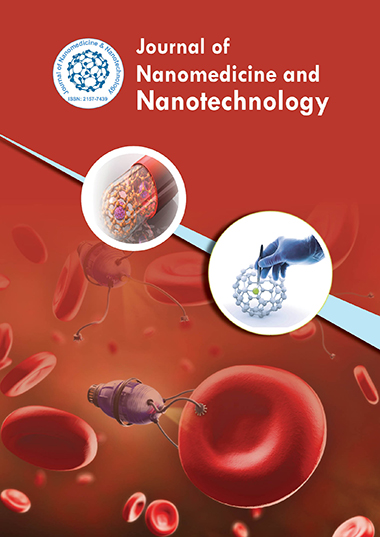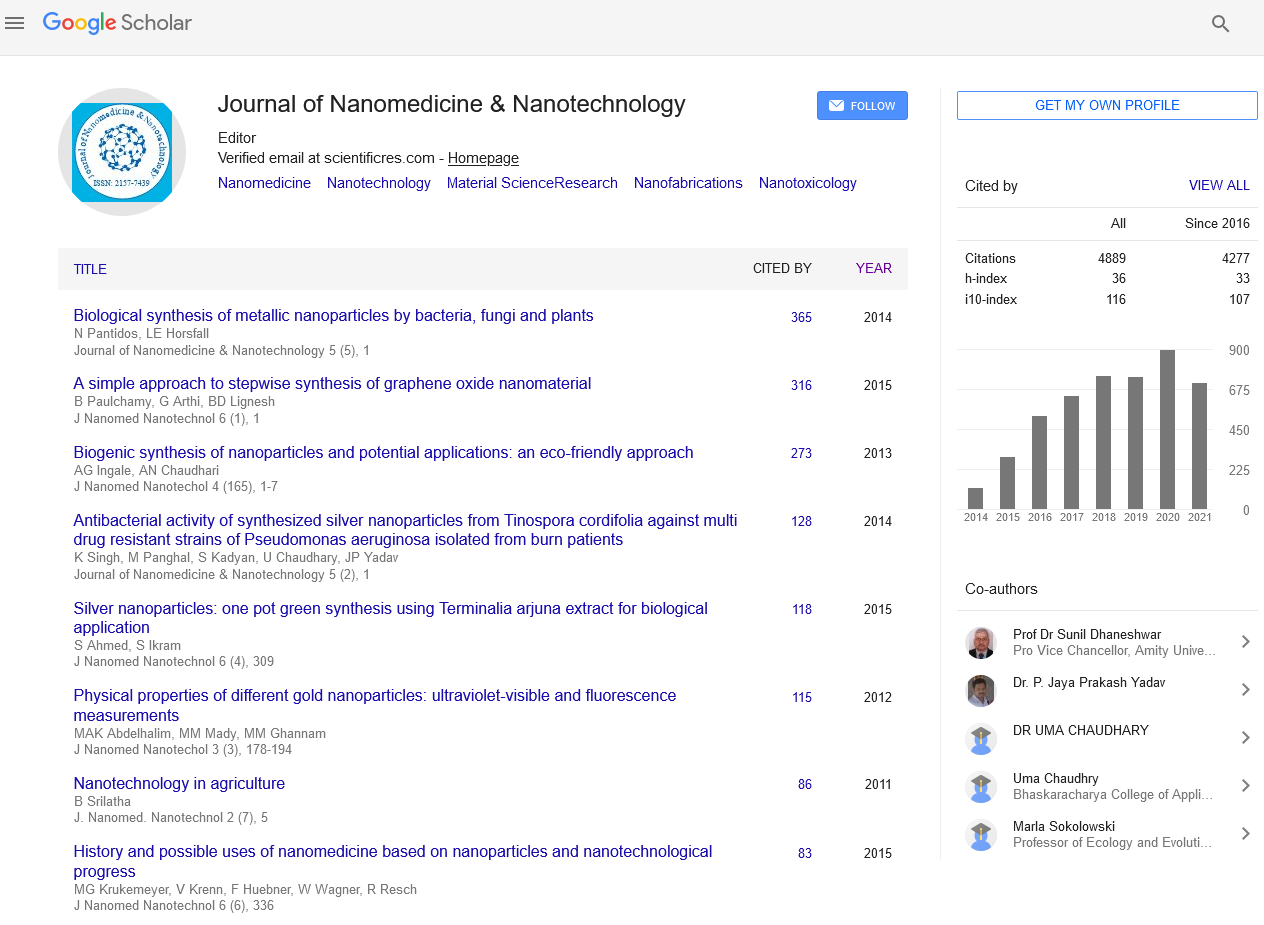Indexed In
- Open J Gate
- Genamics JournalSeek
- Academic Keys
- JournalTOCs
- ResearchBible
- China National Knowledge Infrastructure (CNKI)
- Scimago
- Ulrich's Periodicals Directory
- Electronic Journals Library
- RefSeek
- Hamdard University
- EBSCO A-Z
- OCLC- WorldCat
- SWB online catalog
- Virtual Library of Biology (vifabio)
- Publons
- MIAR
- Scientific Indexing Services (SIS)
- Euro Pub
- Google Scholar
Useful Links
Share This Page
Journal Flyer

Open Access Journals
- Agri and Aquaculture
- Biochemistry
- Bioinformatics & Systems Biology
- Business & Management
- Chemistry
- Clinical Sciences
- Engineering
- Food & Nutrition
- General Science
- Genetics & Molecular Biology
- Immunology & Microbiology
- Medical Sciences
- Neuroscience & Psychology
- Nursing & Health Care
- Pharmaceutical Sciences
Editorial - (2025) Volume 16, Issue 1
Bioactive Nanocoatings for Enhancing Bone Regeneration in Orthopedic Implants
Solene Dupont*Received: 01-Jan-2025, Manuscript No. jnmnt-25-28314; Editor assigned: 03-Jan-2025, Pre QC No. jnmnt-25-28314 (PQ); Reviewed: 16-Jan-2025, QC No. jnmnt-25-28314; Revised: 23-Jan-2025, Manuscript No. jnmnt-25-28314 (R); Published: 31-Jan-2025, DOI: 10.35248/2157-7439.24.16.767
INTRODUCTION
Orthopedic implants, including joint replacements, fracture fixation devices, and spinal implants, are commonly used to treat musculoskeletal injuries and degenerative diseases. While these implants can restore function and alleviate pain, their long-term success depends largely on their ability to integrate with surrounding bone tissue, a process known as osseointegration. Despite advances in implant materials, the challenge of improving osseointegration and preventing implant failure remains significant. Bioactive nanocoatings have emerged as a promising solution to enhance the biological performance of orthopedic implants, promoting bone regeneration and improving implant longevity. This article explores the use of bioactive nanocoatings for enhancing bone regeneration in orthopedic implants, discussing their mechanisms, benefits, and potential future developments [1].
BONE REGENERATION AND OSSEOINTEGRATION
Bone regeneration refers to the process by which new bone tissue forms to repair defects or replace damaged bone. In orthopedic implants, achieving effective osseointegration is essential for ensuring the stability and functionality of the implant. When an implant is inserted into bone, it must interact with the surrounding bone tissue to create a stable interface. This interaction involves the formation of a bone-bonding layer at the implant surface, which promotes the migration, attachment, and differentiation of osteoblasts (bone-forming cells). The success of osseointegration depends on several factors, including the material properties of the implant, surface roughness, and chemical composition [2]. Traditional orthopedic implant materials, such as titanium and stainless steel, are biocompatible and mechanically strong but may not fully promote bone regeneration on their own. To address this limitation, bioactive nanocoatings have been developed to modify the implant surface, making it more conducive to bone growth and integration. These nanocoatings can mimic the natural extracellular matrix (ECM) of bone and provide a favorable environment for osteoblasts to adhere, proliferate, and differentiate, thereby enhancing the overall success of the implant [3].
BIOACTIVE NANOCOATINGS MECHANISMS AND PROPERTIES
Bioactive nanocoatings are thin layers of nanomaterials that are applied to the surface of orthopedic implants. These coatings are designed to interact with the surrounding biological environment, promoting favorable cellular responses that support bone regeneration. The key properties of bioactive nanocoatings include biocompatibility, osteoinductivity (the ability to stimulate bone formation), and osteoconductivity (the ability to support bone cell attachment and growth). One of the most widely studied bioactive nanocoatings is hydroxyapatite (HA), a naturally occurring mineral form of calcium phosphate that is the primary inorganic component of bone. HA-based nanocoatings have been shown to enhance osteoblast attachment and promote bone formation at the implant surface. These coatings can be applied using various techniques, such as electrochemical deposition, sol-gel processes, or chemical vapor deposition, to achieve a controlled surface structure that mimics the nanostructure of bone [4]. In addition to HA, other bioactive nanomaterials, such as bioactive glasses, calcium phosphates, and nanoceramics, are also being explored for use in orthopedic implant coatings. These materials can release ions, such as calcium, phosphate, and silicon, which have been shown to stimulate osteoblast activity, increase collagen deposition, and enhance bone mineralization. Furthermore, nanocoatings can be designed to incorporate growth factors, such as bone morphogenetic proteins (BMPs), which can further accelerate the bone healing process. The nanoscale features of the coating, including its surface roughness, porosity, and texture, are crucial for influencing cellular behavior. Nanostructures can mimic the natural bone architecture, allowing for improved cell adhesion, migration, and differentiation. For example, nanopillars or nanofibers on the surface of an implant can enhance osteoblast attachment and guide cell alignment, which is important for the formation of a stable bone-implant interface [5].
BENEFITS OF BIOACTIVE NANOCOATINGS FOR BONE REGENERATION
The use of bioactive nanocoatings in orthopedic implants offers several significant benefits that can improve both the short-term and long-term success of the implants. One of the primary advantages is the enhancement of osseointegration. By promoting osteoblast adhesion and differentiation at the implant surface, bioactive nanocoatings facilitate the formation of a stable bone-implant interface, which is essential for implant stability and durability. This improved osseointegration can reduce the risk of implant loosening, a common cause of implant failure. Another key benefit of bioactive nanocoatings is their ability to accelerate bone healing. In patients with fractures or bone defects, implants coated with bioactive materials can stimulate the formation of new bone tissue, improving the healing process. This is particularly important in patients with compromised bone quality, such as those with osteoporosis, where bone regeneration may be slower or less effective. Bioactive nanocoatings can also reduce the risk of implant-associated infections. Certain nanomaterials, such as silver nanoparticles, have antimicrobial properties that can help prevent bacterial colonization on the implant surface. This can decrease the incidence of postoperative infections, which are a significant complication in orthopedic surgeries and can lead to implant failure [6]. Finally, bioactive nanocoatings can be engineered to provide controlled release of therapeutic agents, such as growth factors, antibiotics, or anti-inflammatory drugs. This controlled release can provide localized treatment to the surrounding tissues, enhancing bone regeneration while preventing infection or inflammation. The ability to deliver multiple therapeutic agents through a single nanocoating makes this approach highly versatile and effective [7].
CHALLENGES AND FUTURE DIRECTIONS
Despite the promising potential of bioactive nanocoatings, several challenges remain in their clinical implementation. One of the primary challenges is ensuring the long-term stability of the coatings. Over time, bioactive coatings may degrade or lose their effectiveness, which could compromise the success of the implant. Researchers are working to develop more durable coatings that can maintain their bioactivity over extended periods. Another challenge is the variability in patient-specific factors, such as age, underlying health conditions, and the presence of comorbidities, which can affect the rate of bone healing and osseointegration [8]. To address this, personalized approaches to implant coatings are being explored, where the composition and properties of the nanocoating are tailored to individual patient needs. Furthermore, the manufacturing and scalability of bioactive nanocoatings present significant hurdles. While laboratory-scale production of nanocoatings is feasible, translating these technologies to large-scale manufacturing in a cost-effective and reproducible manner remains a challenge [9]. Standardization of coating techniques and quality control measures will be crucial to ensure consistent results in clinical applications [10].
CONCLUSION
Bioactive nanocoatings offer a promising approach to enhancing bone regeneration and improving the success of orthopedic implants. By promoting osseointegration, accelerating bone healing, and providing controlled release of therapeutic agents, these coatings can significantly improve the clinical outcomes of implant surgeries. While challenges remain, ongoing research into the development of more durable, personalized, and scalable nanocoatings will likely lead to the widespread clinical adoption of this technology, ultimately benefiting patients with musculoskeletal disorders and injuries.
REFERENCES
- Dong Y, Li Z, Zhou J. A new class of biocompatible and luminescent carbogenic nanodots for bioimaging. Chemical Communications. 2020; 46(46): 2761-2763.
- Soe Z C, Thapa R K, Ou W, Gautam M, Nguyen, H T, Jin et al. Folate receptor-mediated celastrol and irinotecan combination delivery using liposomes for effective chemotherapy in colorectal cancer mouse xenografts. Journal of Controlled Release.2019; 303: 1-15.
- Yao V J, D'Angelo S, Butler K S, Theron C, Smith T L, Marchio S, et al. Ligand-targeted theranostic nanomedicines against cancer. Chemical Reviews. 2016; 116(6): 3436-3486.
- Balasubramanian P, Yang L, Lang J C, Jatana K R, Schuller D. Aloe-emodin induces chemo-radiosensitivity in human hepatocellular carcinoma cells via modulating p53-mediated apoptosis. J Exp Clin Cancer Res. 2014; 33(1): 1-14.
- Brown, D M, Donaldson K, Stone V, Clouter A. The effects of PM10 particles and oxidative stress on macrophages and lung epithelial cells: modulating effects of calcium signalling agonists and antagonists. Thorax. 2020; 58(4): 271-279.
- Sutradhar K B, Sumi C D, Al-Mahmood A K. DPPH free radical scavenging activity of some Bangladeshi medicinal plants. Journal of Acute Disease. 2014; 3(3):182-185.
- Huang B, Abraham W D, Zheng Y, Bustamante Lopez S C. Breaking Through Tumor Hypoxia: Developing Hypoxia-Targeting Nanoparticles. Crit Rev Ther Drug Carr Syst. 2018; 35(5): 433-469.
- Burrell R A, McGranahan N, Bartek J, Swanton C. The causes and consequences of genetic heterogeneity in cancer evolution. Nature. 2018; 501(7467): 338-345.
- Tong R, Chiang, H H, Kohane D S. Photoswitchable nanoparticles for in vivo cancer chemotherapy. Proceedings of the National Academy of Sciences. 2019; 110(46): 19048-19053.
- Gupta A, Kumar R, Jha A. Preparation, characterization, and application of magnetic nanoparticles for gene delivery and imaging. Journal of Nanoparticles. 2019; 2013: 1-14.
Indexed at, Google Scholar, Crossref
Indexed at, Google Scholar, Crossref
Indexed at, Google Scholar, Crossref
Indexed at, Google Scholar, Crossref
Indexed at, Google Scholar, Crossref
Indexed at, Google Scholar, Crossref
Indexed at, Google Scholar, Crossref
Citation: Solene D (2025) Bioactive Nanocoatings for Enhancing Bone Regeneration in Orthopedic Implants. J Nanomed Nanotech. 16: 767.
Copyright: ©2025 Solene D. This is an open-access article distributed under the terms of the Creative Commons Attribution License, which permits unrestricted use, distribution, and reproduction in any medium, provided the original author and source are credited.


